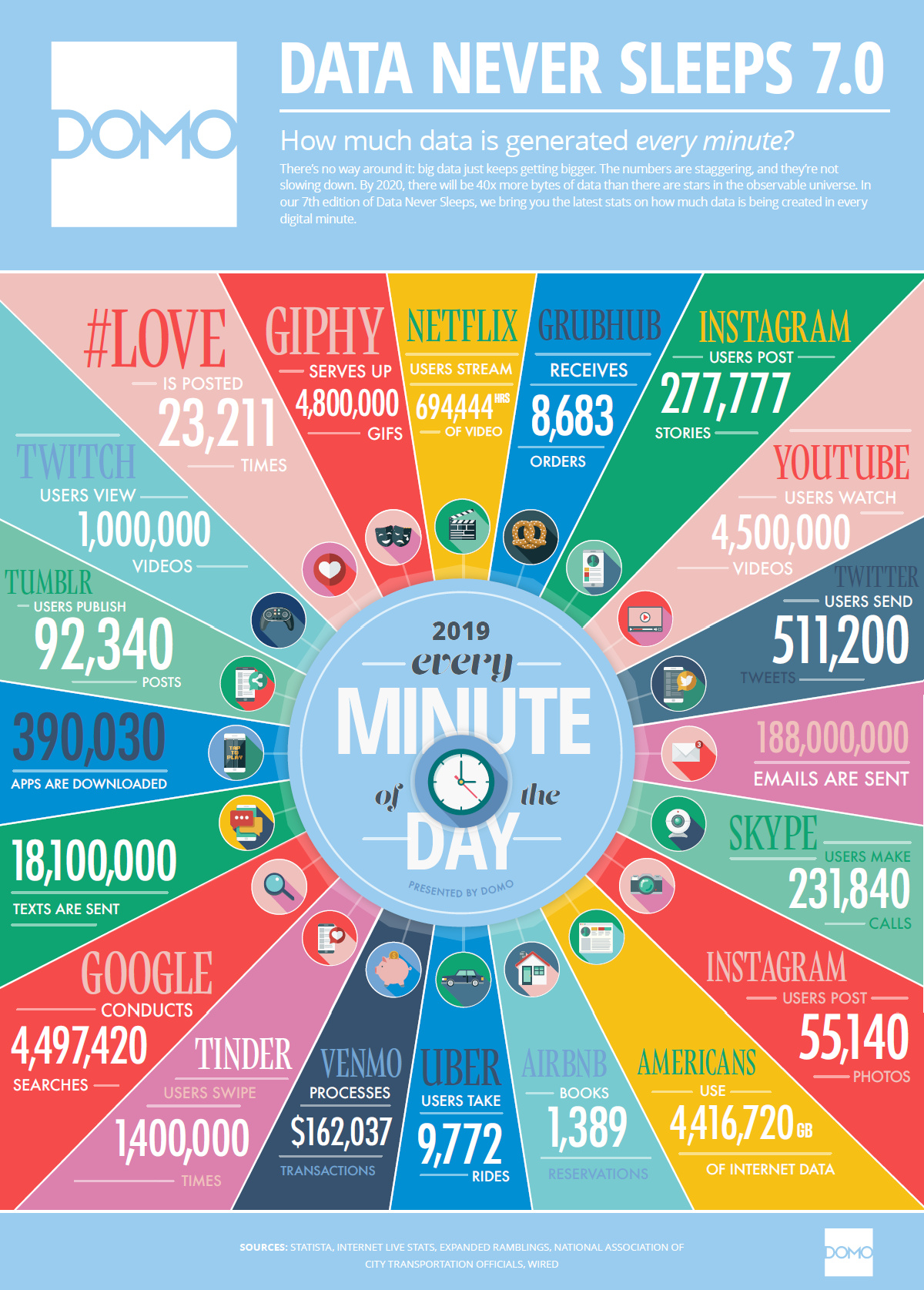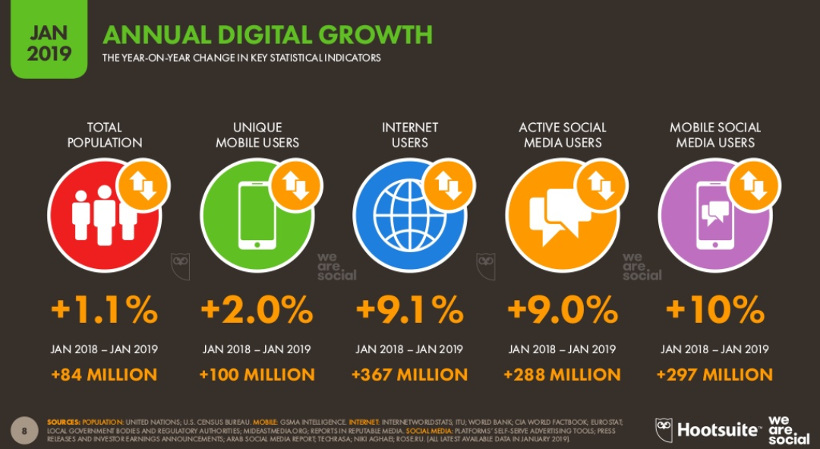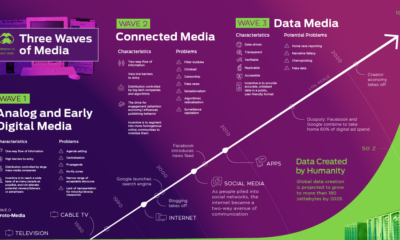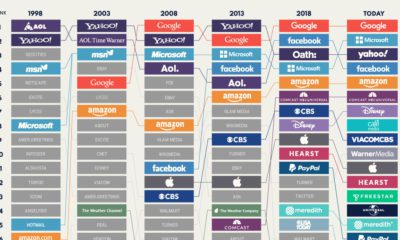Technology
Why Big Data Keeps Getting Bigger

Why Big Data Keeps Getting Bigger
The sun never sets on the creation of new data.
Yes, the rate of generation may slow down at night as people send fewer emails and watch fewer videos. But for every person hitting the hay, there is another person on the opposite side of the world that is turning their smartphone on for the day.
As a result, the scale of data being generated—even when we look at it through a limited lens of one minute at a time—is quite mind-boggling to behold.
The Data Explosion, by Source
Today’s infographic comes to us from Domo, and it shows the amount of new data generated each minute through several different platforms and technologies.
Let’s start by looking at what happens every minute from a broad perspective:
- Americans use 4,416,720 GB of internet data
- There are 188,000,000 emails sent
- There are 18,100,000 texts sent
- There are 390,030 apps downloaded
Now lets look at platform-specific data on a per minute basis:
- Giphy serves up 4,800,000 gifs
- Netflix users stream 694,444 hours of video
- Instagram users post 277,777 stories
- Youtube users watch 4,500,000 videos
- Twitter users send 511,200 tweets
- Skype users make 231,840 calls
- Airbnb books 1,389 reservations
- Uber users take 9,772 rides
- Tinder users swipe 1,400,000 times
- Google conducts 4,497,420 searches
- Twitch users view 1,000,000 videos
Imagine being given the task to build a server infrastructure capable of handling any of the above items. It’s a level of scale that’s hard to comprehend.
Also, imagine how difficult it is to make sense of this swath of data. How does one even process insights from the many billions of Youtube videos watched per day?
Why Big Data is Going to Get Even Bigger
The above statistics are already mind-bending, but consider that the global total of internet users is still growing at roughly a 9% clip. This means the current rate of data creation is still just scratching the surface of its ultimate potential.
In fact, as We Are Social’s recent report on internet usage reveals, a staggering 367 million new internet users were added in between January 2018 and January 2019:

Global internet penetration sits at 57% in 2019, meaning that billions of more people are going to be using the above same services—including many others that don’t even exist yet.
Combine this with more time spent on the internet per user and technologies like 5G, and we are only at the beginning of the big data era.
Technology
Visualizing AI Patents by Country
See which countries have been granted the most AI patents each year, from 2012 to 2022.

Visualizing AI Patents by Country
This was originally posted on our Voronoi app. Download the app for free on iOS or Android and discover incredible data-driven charts from a variety of trusted sources.
This infographic shows the number of AI-related patents granted each year from 2010 to 2022 (latest data available). These figures come from the Center for Security and Emerging Technology (CSET), accessed via Stanford University’s 2024 AI Index Report.
From this data, we can see that China first overtook the U.S. in 2013. Since then, the country has seen enormous growth in the number of AI patents granted each year.
| Year | China | EU and UK | U.S. | RoW | Global Total |
|---|---|---|---|---|---|
| 2010 | 307 | 137 | 984 | 571 | 1,999 |
| 2011 | 516 | 129 | 980 | 581 | 2,206 |
| 2012 | 926 | 112 | 950 | 660 | 2,648 |
| 2013 | 1,035 | 91 | 970 | 627 | 2,723 |
| 2014 | 1,278 | 97 | 1,078 | 667 | 3,120 |
| 2015 | 1,721 | 110 | 1,135 | 539 | 3,505 |
| 2016 | 1,621 | 128 | 1,298 | 714 | 3,761 |
| 2017 | 2,428 | 144 | 1,489 | 1,075 | 5,136 |
| 2018 | 4,741 | 155 | 1,674 | 1,574 | 8,144 |
| 2019 | 9,530 | 322 | 3,211 | 2,720 | 15,783 |
| 2020 | 13,071 | 406 | 5,441 | 4,455 | 23,373 |
| 2021 | 21,907 | 623 | 8,219 | 7,519 | 38,268 |
| 2022 | 35,315 | 1,173 | 12,077 | 13,699 | 62,264 |
In 2022, China was granted more patents than every other country combined.
While this suggests that the country is very active in researching the field of artificial intelligence, it doesn’t necessarily mean that China is the farthest in terms of capability.
Key Facts About AI Patents
According to CSET, AI patents relate to mathematical relationships and algorithms, which are considered abstract ideas under patent law. They can also have different meaning, depending on where they are filed.
In the U.S., AI patenting is concentrated amongst large companies including IBM, Microsoft, and Google. On the other hand, AI patenting in China is more distributed across government organizations, universities, and tech firms (e.g. Tencent).
In terms of focus area, China’s patents are typically related to computer vision, a field of AI that enables computers and systems to interpret visual data and inputs. Meanwhile America’s efforts are more evenly distributed across research fields.
Learn More About AI From Visual Capitalist
If you want to see more data visualizations on artificial intelligence, check out this graphic that shows which job departments will be impacted by AI the most.
-

 Mining1 week ago
Mining1 week agoGold vs. S&P 500: Which Has Grown More Over Five Years?
-

 Markets2 weeks ago
Markets2 weeks agoRanked: The Most Valuable Housing Markets in America
-

 Money2 weeks ago
Money2 weeks agoWhich States Have the Highest Minimum Wage in America?
-

 AI2 weeks ago
AI2 weeks agoRanked: Semiconductor Companies by Industry Revenue Share
-

 Markets2 weeks ago
Markets2 weeks agoRanked: The World’s Top Flight Routes, by Revenue
-

 Countries2 weeks ago
Countries2 weeks agoPopulation Projections: The World’s 6 Largest Countries in 2075
-

 Markets2 weeks ago
Markets2 weeks agoThe Top 10 States by Real GDP Growth in 2023
-

 Demographics2 weeks ago
Demographics2 weeks agoThe Smallest Gender Wage Gaps in OECD Countries














